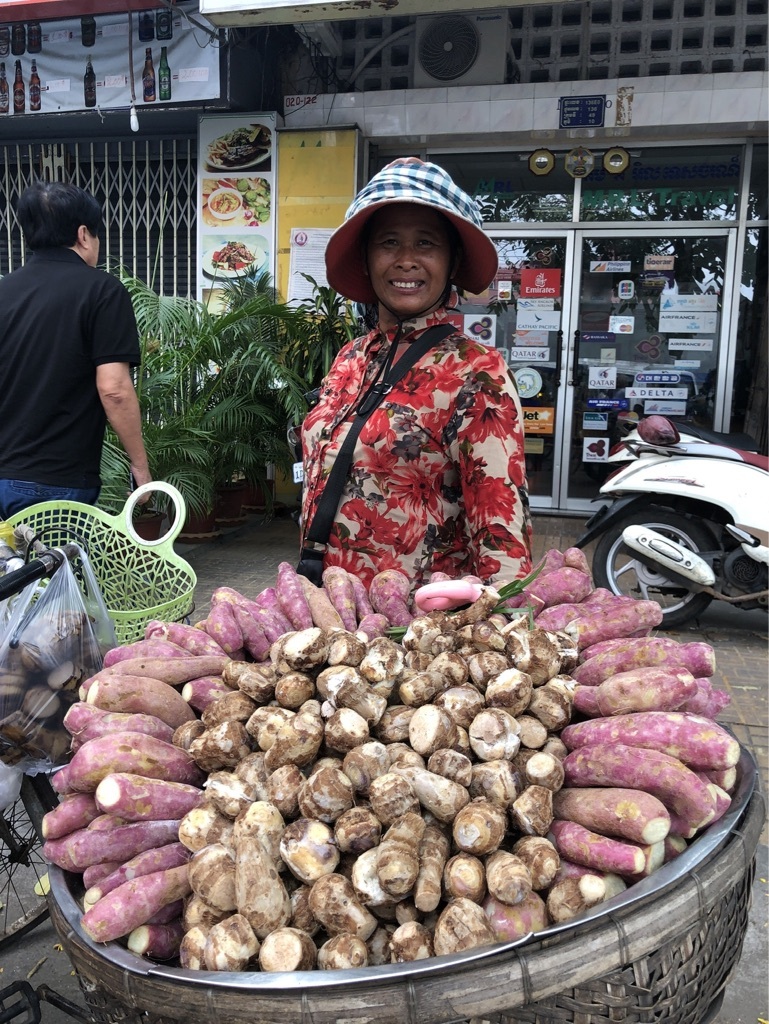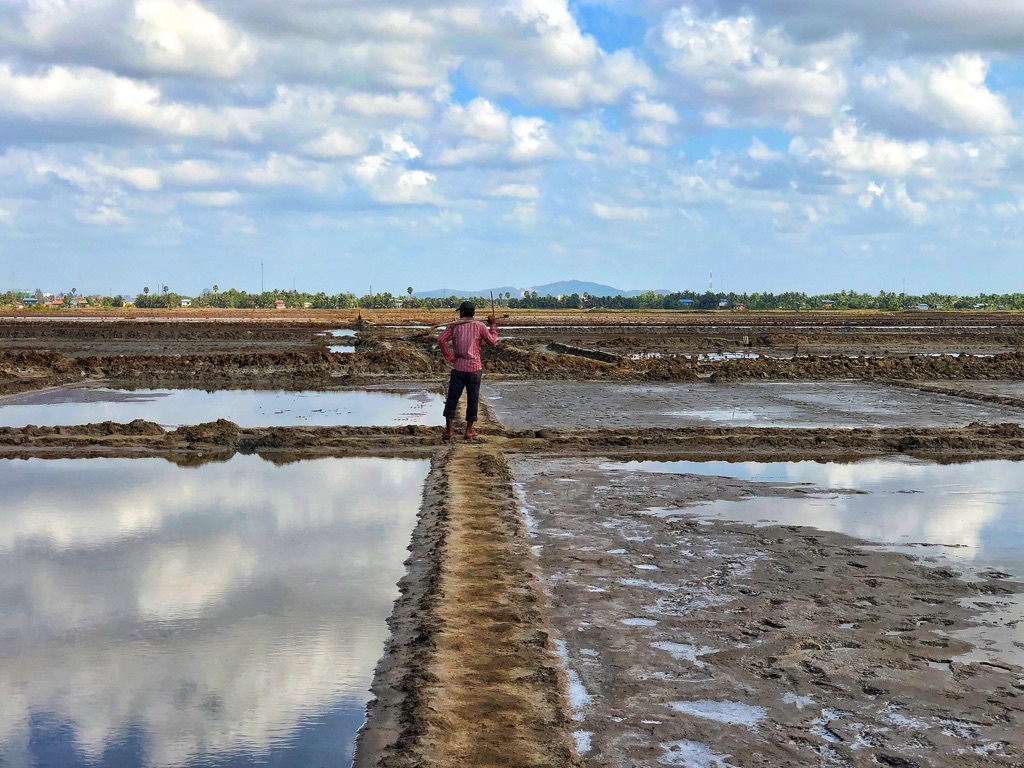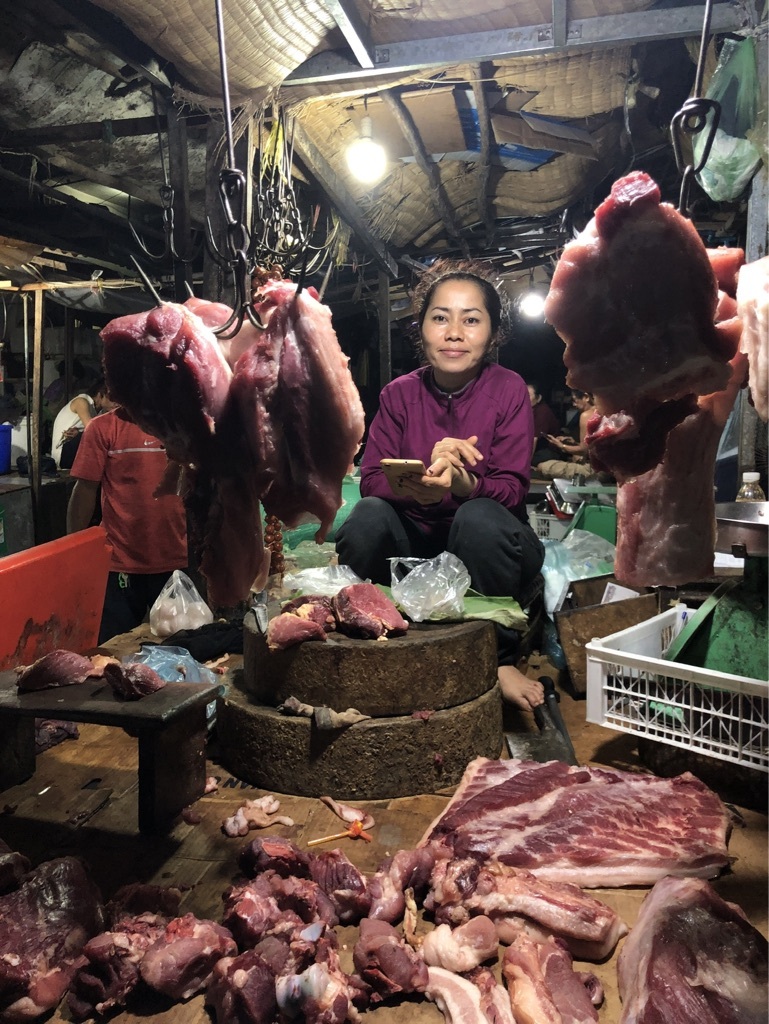In northern Cambodia, even the names exude an ancient romanticism. Angkor Wat. Phnom Bakheng. Phimeanakas. Meandering miles of movie-perfect temples. Join the masses at dawn and stumble through, awed by the stone intricacies of lost centuries.
In southern Cambodia, it’s a romance of a different sort, a marriage taken for granted turned on its head. Unfurling across the shores and valleys of Kampot Province—1,800 square miles wedged between the Gulf of Thailand and Vietnam—is the soul of Cambodian food: salt and pepper. But not how we know them.
Start at the coast, where men with pant legs rolled wade methodically across a mirror-like grid cut into brown earth, ponds sectioned by a patchwork of ochre dirt roads stretched to a stark horizon. Get closer and the mirrors break into a million refractions of captured light.
The men dredge rakes and the shards pile, glinting crystals mounding and breaking the water’s surface. They are harvesting the salt of the sea, coarse flakes that turn brittle in the sun before being heaped in barn-like sheds to be bagged in 50-kilogram sacks. Taste a pinch and your mouth pops with minerals and brine.
Elsewhere in the world, salt this good would take the lead. But in Cambodia, it’s backseated to the long-revered Kampot peppercorn, one of a few bold flavors—mostly fermented fish products—that define Cambodian cooking, an amalgam of Chinese, Muslim, Vietnamese and French overlays to local ingredients.
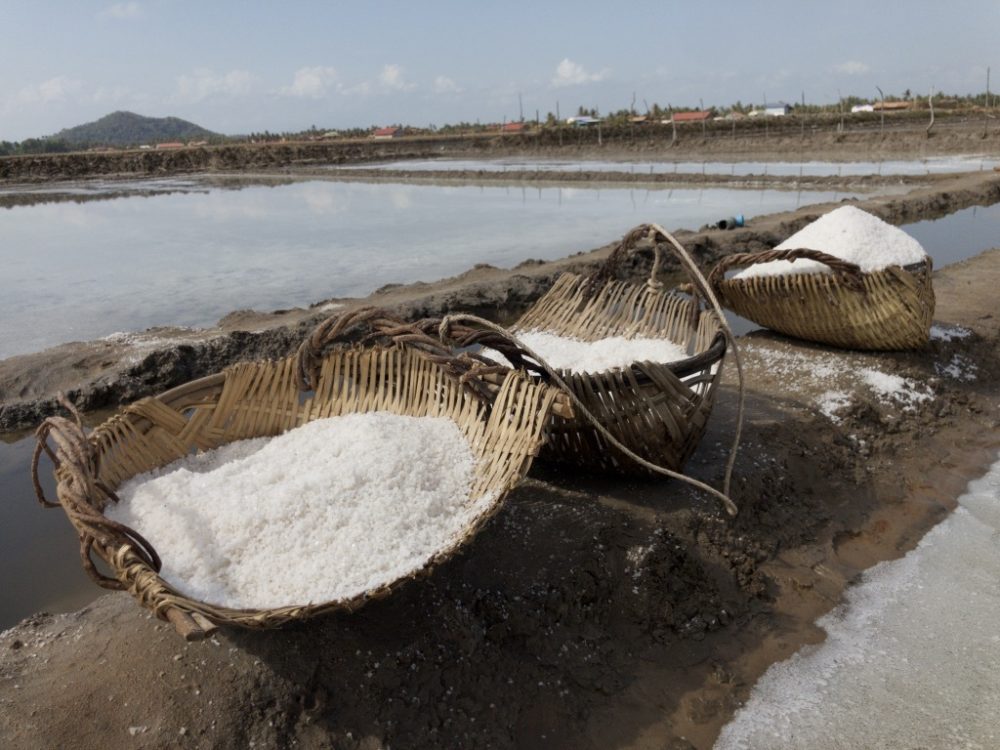
Sea salt is harvested along Kampot's coast
In Europe and the U.S., ground black pepper most often is sprinkled habitually, a table seasoning used sparingly and without expectations. It is relegated to salt’s obligatory plus-one, the guest who never quite understands why he was invited.
In Cambodia, pepper—brought by the Chinese around the 12th century—is a cooking spice, added before, during and after. Copiously. It has presence, floral and strong. It has texture, never ground finely, insisting on being seen, felt and crunched as much as tasted and smelled.
And it shows up everywhere, adding bright warmth to cocktails, meat, seafood and sauces. It is used in such volume—not just overall, but within each dish—it leaves your mouth with a boisterous, pleasant buzz. Unlike chili pepper heat, which lingers and burns, peppercorns offer transient pops of fiery, fleeting flavor.
To better understand Cambodia’s relationship with pepper—and, in fact, peppercorns themselves—I rent a scooter and head several miles inland, dusting along rutted and winding dirt roads in wet wool heat. Past flat valleys with palm tree punctuation. Past ramshackle villages where petrol is sold in old glass Pepsi and Johnnie Walker bottles. Past barbershops little more than a chair and a tub of water at the edge of the road.
As you round Tomnop Tek Krolar, or The Secret Lake—a dazzling man-made body of water whose secret is that it is a grave for the thousands of slaves the Khmer Rouge forced to build it—you find the fringe of Kampot country, a hilly and protected region that once provided all the peppercorns for France.
The first revelation is that all peppercorns, no matter the color, come from the same berry.
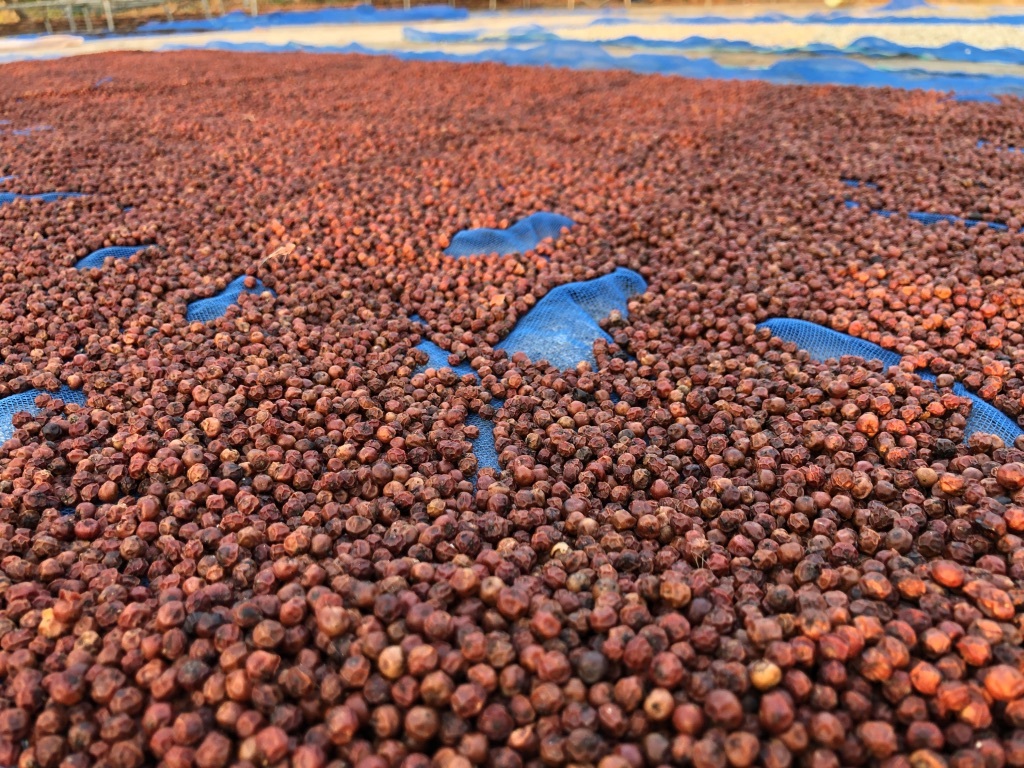
As recently as the 1960s, Kampot produced thousands of tons of peppercorns—green, black, red and white—but by the 1980s Pol Pot’s genocide had wiped out nearly all the plants—considered a sign of luxury best eliminated—as well as the knowledge of how to cultivate them. Only during the last 15 years have the plantations slowly rebounded.
Bo Tree Farm is one of just 440 or so plantations today, all of which must grow their peppercorns organically, using nothing—not water, soil nor fertilizer—from outside Kampot. The farm itself is small, but the plants dwarf you, three or four vines clustered and climbing 10 feet or more up bamboo poles or towers of stacked bricks. Hundreds of these clusters—each covered in tight bundles of tiny green berries—huddle under mesh tarps and straw thatch that partly shade and protect the vines. The effect is maze-like as you wander between them.
The first revelation is that all peppercorns, no matter the color, come from the same berry. Most are picked when green, then sorted. Anything too small is consumed fresh or pickled with sea salt to sprinkle on salads or seafood. The rest—which must be 4 to 5 millimeters round—are briefly boiled, then spread on sheets on the ground to dry in the sun for up to seven days. Their skins shrivel, harden and dull to black.
If allowed to remain on the vine, those same green peppercorns eventually turn bright red and can be harvested and processed in a similar manner to produce red peppercorns, which have a milder flavor typically paired with fruit and sweets. Remove the red skins—a tedious process done by hand—and you are left with white peppercorns, even milder and often used to season chicken and pork.
The second revelation is when Tim Mann Thoem, the farm’s cook, introduces me to two dishes that exemplify Cambodia’s penchant for peppercorns. Each uses them—one white, the other black—gratuitously, heaping tablespoon after heaping tablespoon, infusing the dish, the air, even our fingertips.
Using recipes taught to him by his mother, he begins with amok, Cambodia’s national dish. It typically is made with white fish and vegetables seasoned with white pepper and cooked in a coconut milk and lemon grass curry, then served in a folded banana leaf. Thoem prefers chicken paired with eggplant and sweet potatoes.
Working in an open brick kitchen that overlooks the plantation, he begins, of course, with the peppercorns. Multiple tablespoons are pounded gritty in a mortar and pestle. He then makes the curry paste—a mash of galangal (a relative of ginger), turmeric, garlic and lemon grass—which is briefly sizzled in oil in a Dutch oven before coconut milk and cubed chicken are added. A bit of sugar and fish sauce lend a sweet-and-savory balance, while voluminous crushed white peppercorns add warmth. As the vegetables cook to tender, the air fills with richness.
The amok is finished in about 30 minutes, and the taste defies belief. Despite more than 2 tablespoons of white pepper per serving, the flavor remains a gentle backdrop, sweet and floral, more warm than hot. The coarse peppercorns, it turns out, play as well with the savory, tender chicken as with the sweet and starchy sweet potatoes, adding warmth and crunch.
The second dish—Kampot pepper chicken—takes just as liberal a hand with the peppercorns, this time black. It’s a simple chicken, green bean and carrot stir-fry that tastes anything but. What distinguishes it is the full 3 tablespoons of crushed peppercorns. In the finished dish—less saucy than the amok—they have an almost breadcrumb-like quality, coating the chicken and vegetables. Each bite boils over with flavor, all balanced by the sweetness of the carrots and a repeat of the fish sauce-sugar combination.
At Milk Street, a bit of suspension of disbelief was needed. Despite our experience in Cambodia, we were certain such volumes of peppercorns would overwhelm the senses. They did not. The marriage of flavors in each dish mitigates the heat to a pleasant burst.
We also worried whether our typical supermarket peppercorns could compare to Kampot peppercorns, a global standard bearer. While the flavors were not quite as fresh and nuanced, they nonetheless were delicious. And when we did hunt down Kampot peppercorns—available at spice shops—the recipes only improved.
It is, however, important to start with whole peppercorns; the flavors are more pronounced when they are freshly crushed; preground pepper often tastes flat and stale. For crushing, we preferred Thoem’s use of a mortar and pestle, the best way to get pleasantly coarse pieces. A spice grinder works, but will grind some of the peppercorns more finely than we liked.
The recipes otherwise adapted easily with just a few substitutions for hard-to-find ingredients, such as ginger for galangal. We did, however, prefer to heat the crushed peppercorns before proceeding with the recipes—blooming the white pepper in a neutral oil and toasting the black pepper in a dry skillet. In both cases, we found the flavors deeper and sweeter.
Suspension of disbelief satisfied. In the end, we loved the upended marriage that finally put pepper on a pedestal.
More From Cambodia

